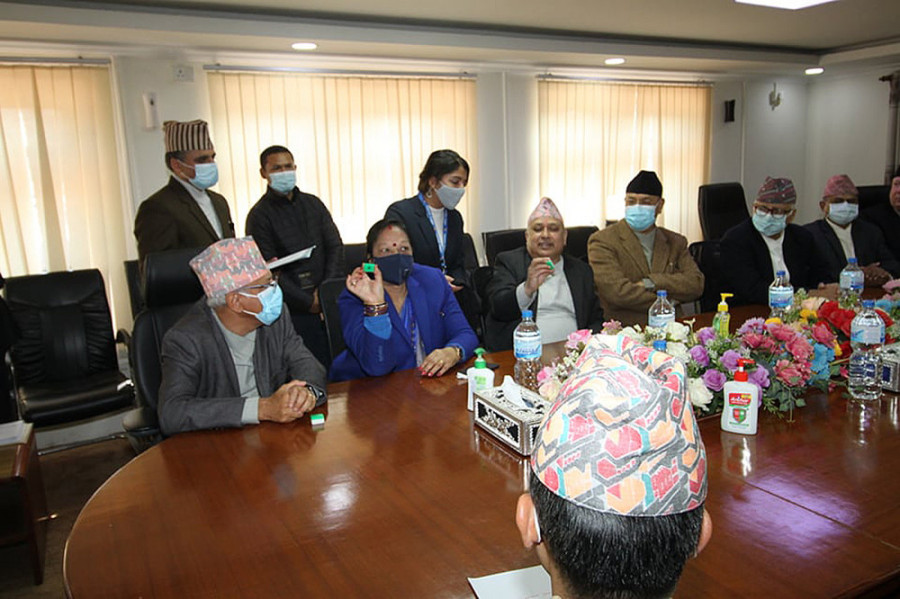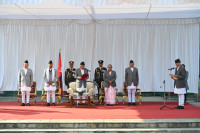National
Supreme Court turns the page with lottery system, but will the crisis end?
More questions remain to be answered as the judiciary problem is more than meets the eye.
Binod Ghimire
Supreme Court justices resumed regular hearings of all kinds of cases on Wednesday, more than a month after they started boycotting benches in protest against Chief Justice Cholendra Shumsher Rana. Of the 19 justices at the Supreme Court, 18 returned to the benches after a lottery system was introduced on Wednesday to decide which bench hears what cases. One justice is currently out of the country.
Introduction of the lottery system was one of the demands of the justices who had accused Chief Justice Rana of assigning cases in an unscrupulous manner, thereby fuelling corruption in the judiciary. The lottery system has ended over a month-long crisis in the judiciary. This system has also snatched away the chief justice’s inherent right to assign cases.
In Nepal’s 70 years of judicial history, it was for the first time the chief justice did not assign cases to justices, who heard cases assigned to them through a lottery system.
Here’s everything you need to know about the controversy in the judiciary, what the lottery system is, how it works and its pros and cons.
What was the problem in the Supreme Court?
Chief Justice Cholendra Shumsher Rana is not new to controversies. His rulings and verdicts had come into question when he was a judge at the then appellate court and Special Court. Despite that, he was appointed Supreme Court chief justice in January 2019.
His role in participating in the Constitutional Council meetings called after amendment to the Constitutional Council (Functions, Duties, Power and Procedure) Act, 2010 and recommending “his people” in different constitutional commissions were highly criticised. The criticism scaled up when reports were out that he sought a share in the Sher Bahadur Deuba’s Cabinet. Gajendra Hamal was said to have been appointed a minister at Rana’s insistence. Rana, however, has denied that.
But it was what triggered the whole controversy.
All the justices of the country’s top court began boycotting the benches starting October 25. Law professionals also joined the protest on October 31. Except for habeas corpus petitions, hearings of all other cases were halted. Hearings of over 2,000 cases could not take place while no new petitions were registered over the period.
What led to the truce?
As justices and lawyers mounted pressure on Rana, the latter exhibited a pretty adamant attitude. He said that he would not resign just because of “calls from some quarters from the streets.” He maintained that he was rather ready to face an impeachment motion. But political parties dragged their feet, showing no signs of making any move to oust Rana from Parliament.
As the standoff continued, justice seekers were deprived of their fundamental right to justice. The judges who had launched the campaign against Rana started feeling the heat, as moral pressure was building. As a middle path to break the deadlock, they prepared a draft to amend the Supreme Court regulations so as to change the system of assigning benches.
On November 18, Rana, as demanded by the justices, called a full court meeting which endorsed the draft and the directive. Rana abstained from the meeting as demanded by the justices. He signed the decision and sent it to the Ministry of Law and Justice for the revision in the regulations. Another full court meeting sans Rana on November 25 decided to adopt the lottery system starting Wednesday.
How does the new system work?
Like in the past, the cause list management team of the Supreme Court prepares a list of cases to be heard for the day. All the cases are grouped into different blocks based on their nature and the numbers and types of benches to be constituted for a particular day. There are separate boxes to keep the lots.
The benches are constituted by drawing lots, which is done at 10am in the presence of the chief justice, justices, chief registrar, and officials from the case management committee and technicians from the information technology department.
The chief justice has no role in assigning benches.
He, however, can draw lots but only for cases that are to be heard by a single bench because justices have said they won’t share any bench with him.
A court official told the Post on Tuesday it was up to Rana if he drew lots. On Wednesday, Rana, however, was not present in the court as he is receiving treatment for Covid-19 at the Armed Police Force Hospital in Balambu, on the outskirts of Kathmandu.
The lots are picked based on the seniority of the justices. Extended full benches, full benches, single benches and division benches are constituted based on the need, depending on the lots picked by the justices from different boxes assigned to each bench. The extended full bench is constituted first, if necessary, and then other benches are formed.
For instance, if an extended full bench with five justices is to be formed, tokens for all the justices present are kept in a box. However, the bench is constituted of justices who pick the numbers from one to five. The remaining justices constitute other benches. And a representative (a justice) from each bench constituted through the draw choses a block of cases categorised by the case management committee.
Does the lottery system end the problem in the judiciary?
It is a stopgap measure, multiple justices have told the Post over the past few weeks.
The lottery system simply bars the chief justice from assigning cases. The reason the chief justice is usually authorized to assign cases stems from the fact that the top administrator allocates benches based on the nature of the cases and expertise of justices.
The main allegation against Rana is that he is the source of all ills in the judiciary. But experts and former and incumbent judges say the rot runs deep. Rana is also accused of not implementing reform measures suggested by a report of Justice Hari Krishna Karki.
But just one person’s exit does not ensure reforms in the judiciary, according to experts.
There have been calls to fix the systemic problems, starting from the appointment of judges, that have plagued the judiciary for long. Political interference has also led to anomalies in the judiciary.
While the justices have said they will not share a bench with the chief justice, lawyers have said they will not participate in hearings conducted by Rana.
This may mean hearings will continue to be affected until Rana remains in office.
Why were no full-fledged hearings conducted on Wednesday despite the introduction of the lottery system?
There were 217 cases for 11 benches as per the lottery system for Wednesday. But only a few cases were heard.
The Nepal Bar Association and the Supreme Court Bar Association that have made Rana’s resignation their bottom line demanded to know who the acting chief justice was.
Rana has been hospitalised since Monday, but he has not handed over the charge of acting chief justice to anyone in his absence. As per the tradition, the seniormost justice is given the charge of acting chief justice, hence technically it should have been Deepak Kumar Karki.
The two umbrella bodies of lawyers demanded that they want to know who the acting chief justice was before they participated in hearings.
What kind of cases may never make it to the cause list?
Since the justices have said they won't share bench with Chief Justice Rana, the Constitutional Bench may not sit in near future, or at least until Rana resigns.
Article 137 (1) of the constitution envisions a Constitutional Bench. It says there shall be a Constitutional Bench that consists of the chief justice and other four justices designated by the chief justice on the recommendation of the Judicial Council.
Though Rana once had agreed not to lead the Constitutional Bench to hear cases where there were doubts of conflict of interest, Justice Hari Phuyal’s bench on September 2 said that it was not possible to constitute the Constitutional Bench without the chief justice.
There’s no clarity on whether an acting chief justice can lead the Constitutional Bench.




 8.12°C Kathmandu
8.12°C Kathmandu















